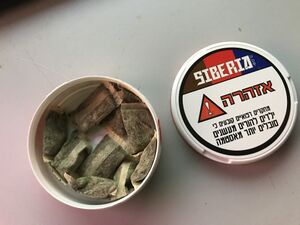Snus
Description

A Swedish invention, Snus is pasteurized and moist granulated tobacco that is used orally.
Properties
- It's mostly portioned into convenient pouches (like teabags). These are available in differing portions, from mini, slim, and up to ordinary sizes.
- Whereas "loose snus" tobacco powder has to be squeezed into spherical/cylindrical shape before use.
- Not chewed, but usually placed behind the upper lip.
- It is available in a range of flavours and strengths to suit any palate / nicotine requirement.
- Produced to a high standard, the processing including pasteurization, results in ultra low levels of nitrosamines and other known carcinogens that occur naturally in tobacco.
- Common ingredients added are 20-60% water, 1.5-3.5% sodium chloride, 1.5- 3.5% humectants, 1.2-3.5% sodium bicarbonate, and less than 1% flavours.
- Can be used for 20-60 min usually, or as long as it still emits flavours or until it liquifies too much.
- Often available for around 5 euro for a tin of 20 (sizing varies).
- Lower nicotine likely implies lower dependency profile than cigarettes, because of slower nicotine absorption (akin to gums).
- Should be stored in the fridge, if infrequently used.
Legal Status
Europe
Illegal to sell in the EU (excluding Sweden), but purchase and use is not illegal (unclear if just due to tobacco industry track record, general opposition to proliferation of further tobacco products, preempting regulation for geographically restrained appeal, or even pharma influence).
Sweden
Snus is legally on the market only in Sweden. The minimum age to purchase is 18 years of age.
UK
Illegal in the UK, but calls have been made by Appgvaping to legalise it's sale. Snus is reasonably easy to obtain in the UK, from sources on social media, and can be ordered online. Little to no enforcement appears to be carried out to block it's transit through customs, or to stop it's use.
North America
The US FDA has authorized the marketing of products through the modified risk tobacco product (MRTP) pathway. The authorizations are for eight Swedish Match USA, Inc. snus smokeless tobacco products sold under the “General” brand name.
FDA authorizes the manufacturer to market these specific products with the claim “Using General Snus instead of cigarettes puts you at a lower risk of mouth cancer, heart disease, lung cancer, stroke, emphysema, and chronic bronchitis.”
The FDA’s review determined that the claim proposed by the company in its application is supported by scientific evidence, that consumers understand the claim and appropriately perceive the relative risk of these products compared to cigarettes, and that the modified risk products, as actually used by consumers, will significantly reduce harm and the risk of tobacco-related disease to individual tobacco users and benefit the health of the population as a whole.
Related Information
Studies
2022: The effect of a non-tobacco-based nicotine pouch on mucosal lesions caused by Swedish smokeless tobacco (snus) (Sara Alizadehgharib, Anna Lehrkinder, Ali Alshabeeb, Anna-Karin Östberg, Peter Lingström)
"Oral mucosal lesions are commonly found in Swedish smokeless tobacco (snus) users where the pouch is placed. These lesions are reversible, that is, clinical and histological tissue changes return to normal following cessation."
"The main aim of this study was to investigate how the oral mucosa was affected if users substituted their regular Swedish snus with non-tobacco-based nicotine products (investigational products)."
"Because of these circumstances, the extent to which the use of the investigational non-tobacco-based nicotine pouch may cause mucosal lesions similar to those produced by regular, tobacco-based snus is unclear. "
2022: Swedish snuff (snus) dipping, cigarette smoking, and risk of peripheral artery disease: a prospective cohort study (Shuai Yuan, Olga E Titova, Scott M Damrauer, Agneta Åkesson, Susanna C Larsson)
"Cigarette smoking but not Swedish snus dipping was associated with an increased risk of PAD (peripheral artery disease)."
2003: Effect of smokeless tobacco (snus) on smoking and public health in Sweden (J Foulds / L Ramstrom / M Burke / K Fagerström)
"Snus availability in Sweden appears to have contributed to the unusually low rates of smoking among Swedish men by helping them transfer to a notably less harmful form of nicotine dependence."
2012: Contrasting snus and NRT as methods to quit smoking. an observational study (J Scheffels / K E Lund / A McNeill)
"Norwegian men frequently use snus as a method for quitting smoking whereas women are more likely to use NRT. The findings indicate that switching to snus can be an effective method for quitting smoking."
2013: Patterns of dual use of snus and cigarettes in a mature snus market (K E Lund / A McNeill), n=3524
Dual use is relatively small. Large percentage of users have stopped smoking, or are planning to by using snus. […]
2015: Time to First Use Among Daily Smokers and Smokeless Tobacco Users (B Rodu / N Plurphanswat / K Fagerström)
"[…] offering some support for the Fagerström-Eissenberg hypothesis that the dependence level of cigarettes is higher than that of ST." (certainly applies to Snus as well)
2019: Snus: a compelling harm reduction alternative to cigarettes (E Clarke / K Thompson / S Weaver / J Thompson / G O’Connell)
"The available scientific data, including long-term population studies conducted by independent bodies, demonstrates that the health risks associated with snus are considerably lower than those associated with cigarette smoking."
Other references
- http://www.smokersonly.org/ on smokeless tobacco as quitting option. Mentions an estimate of ST being 98% less harmful than cigarettes.
- https://snusforumet.se/en/snus-science-database/ - Encompassing research list on Snus Forum.
- https://www.snuson.com/ - Consumer forum.